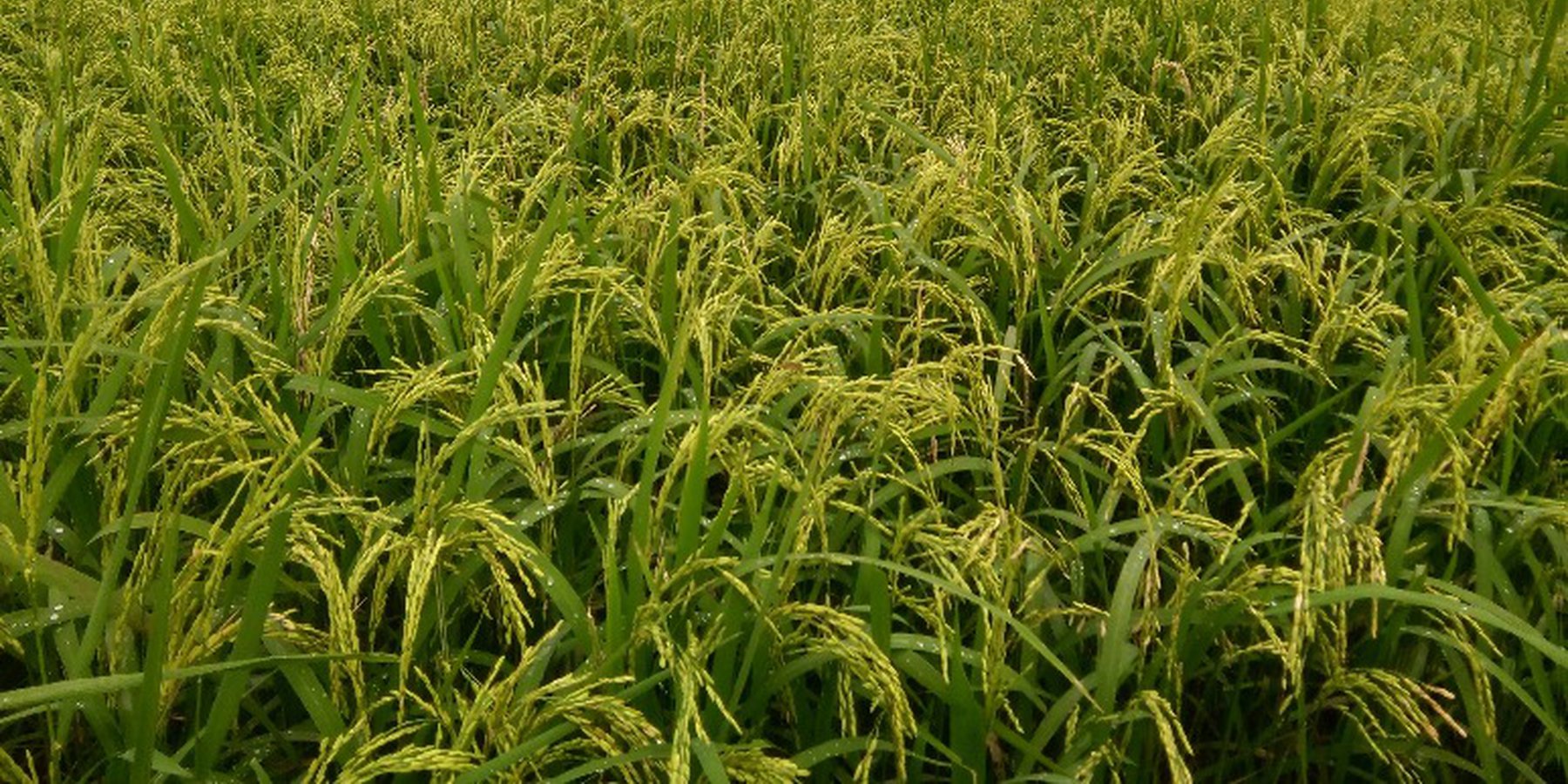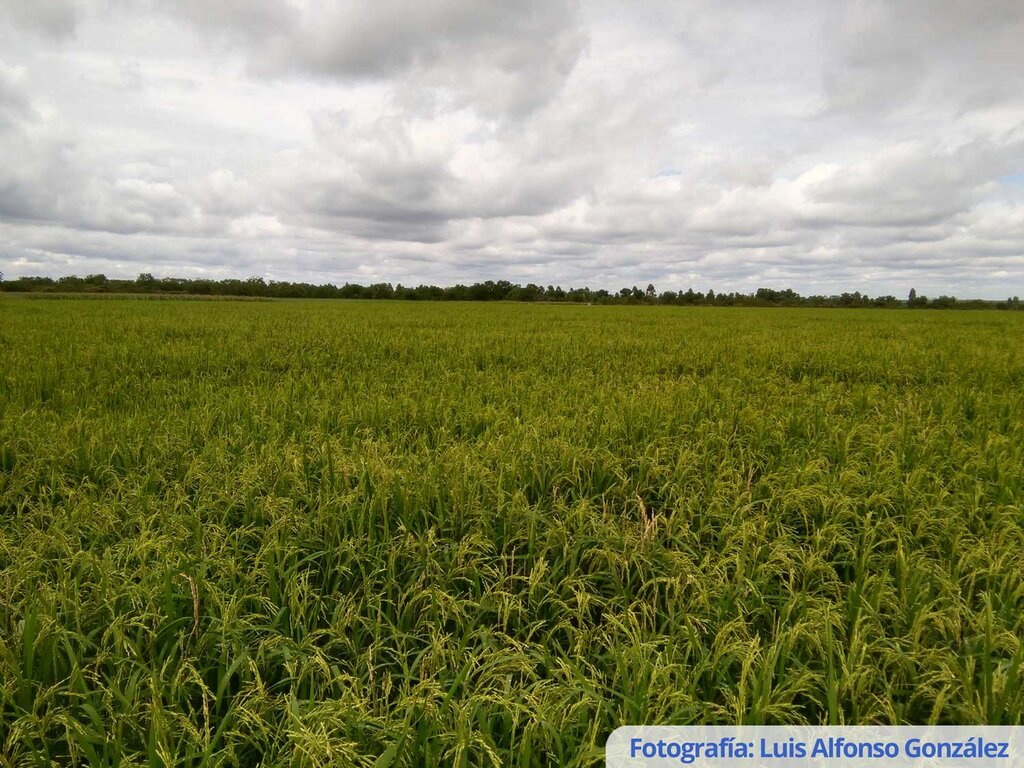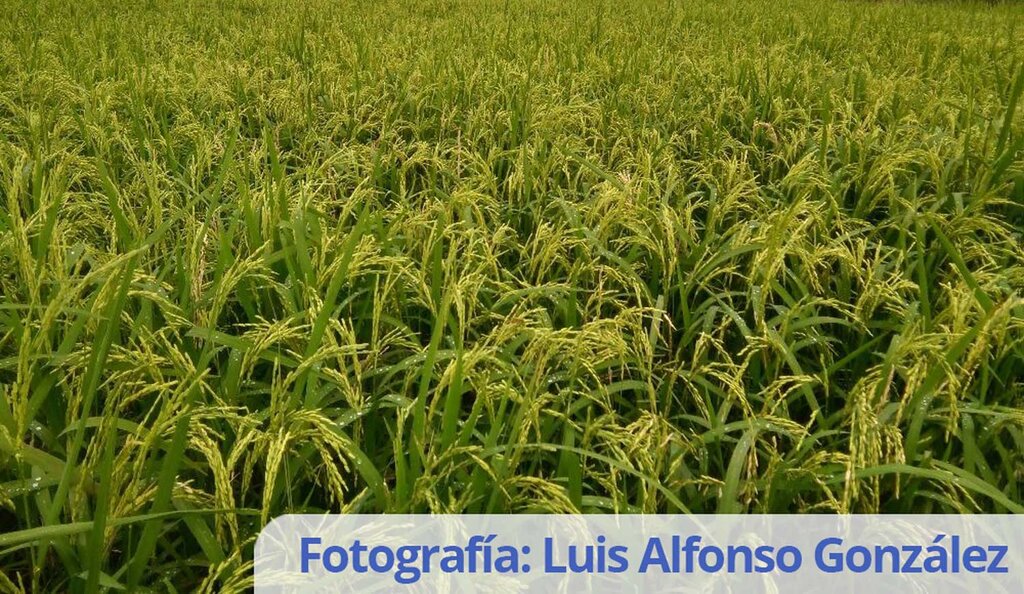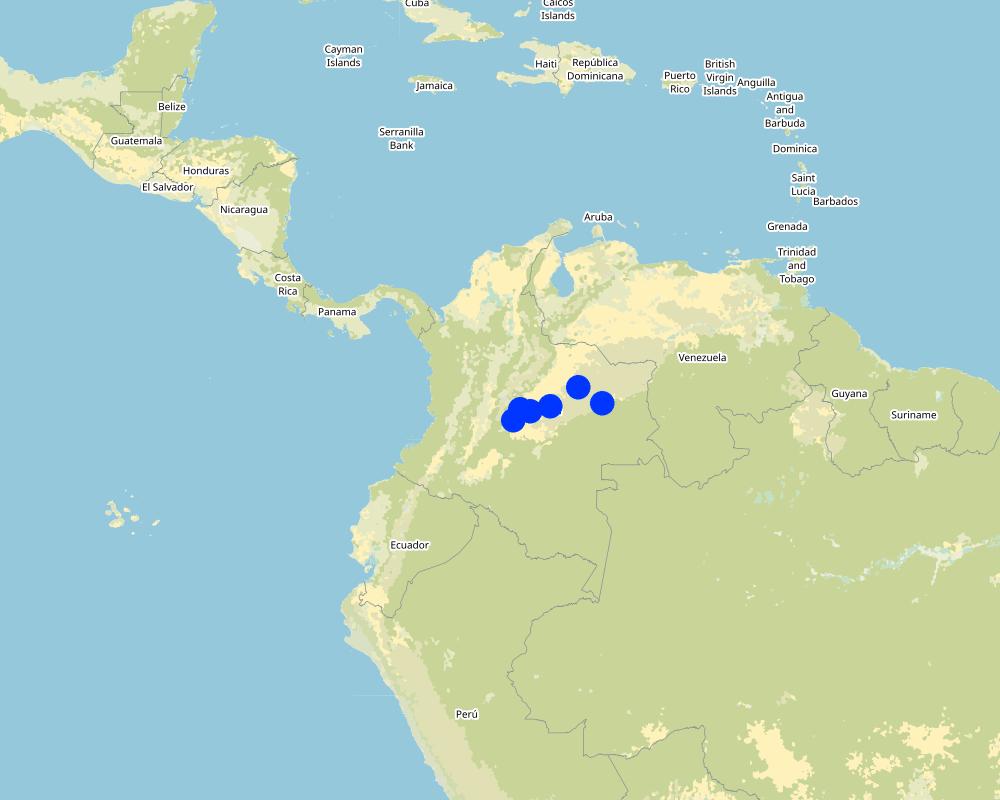Variedad de arroz Llanura 11 [Colombia]
- Creation:
- Update:
- Compiler: Claudia Patricia Rendón Ocampo
- Editor: –
- Reviewers: William Critchley, Mateo Jaimes
Arroz Llanura 11
technologies_5876 - Colombia
View sections
Expand all Collapse all1. General information
1.2 Contact details of resource persons and institutions involved in the assessment and documentation of the Technology
SLM specialist:
Bernal Riobo Jaime Humberto
AGROSAVIA- Corporación colombiana de investigación agropecuaria
Colombia
SLM specialist:
Gallo Gordillo Oscar Javier
AGROSAVIA- Corporación colombiana de investigación agropecuaria
Colombia
SLM specialist:
Baquero Peñuela José Euripides
AGROSAVIA- Corporación colombiana de investigación agropecuaria
Colombia
Name of the institution(s) which facilitated the documentation/ evaluation of the Technology (if relevant)
AGROSAVIA - Corporación colombiana de investigación agropecuaria (AGROSAVIA) - Colombia1.3 Conditions regarding the use of data documented through WOCAT
The compiler and key resource person(s) accept the conditions regarding the use of data documented through WOCAT:
Yes
1.4 Declaration on sustainability of the described Technology
Is the Technology described here problematic with regard to land degradation, so that it cannot be declared a sustainable land management technology?
No
2. Description of the SLM Technology
2.1 Short description of the Technology
Definition of the Technology:
Variedad de arroz precoz (Oryza sativa var. Corpoica Llanura 11) generada para suelos ácidos; cuenta con adaptación a suelos de las sabanas tropicales (oxisoles) de la altillanura plana y terrazas altas del piedemonte Llanero de la Orinoquia Colombiana.
2.2 Detailed description of the Technology
Description:
La altillanura plana de la Orinoquia colombiana comprende una extensión de 4.255.451 ha, de las cuales una gran proporción (60%), corresponde a paisajes de sabana nativa, aptas para el cultivo del arroz con variedades adaptadas a las condiciones edafo-climáticas de la región. Entre estas se destacan la baja capacidad de intercambio catiónico de los suelos, la presencia de aluminio, la acidez alta, los pocos contenidos de fósforo y de materia orgánica; precipitación pluvial que oscila entre 1500 a 3000 mm año, con un periodo seco característico de noviembre a febrero-marzo.
Debido a la adaptación especifica para suelos muy ácidos principalmente Oxisoles, la variedad de Arroz Corpoica Llanura 11 requiere bajo uso de insumos como cales y elementos nutritivos, lo que lo convierte en una excelente alternativa agrícola para colonizar estos agroecosistemas de la altillanura plana y las terrazas altas del Piedemonte Llanero. Así mismo, sus características genéticas la convierten en una de las pocas alternativas de recurso genético arrocero bajo el sistema de secano para las condiciones de las sabanas naturales de esta región.
Igualmente, su adaptación y precocidad (90 - 105 días después de establecido) lo convierten en un cultivo altamente adecuado en los sistemas agro-pastoriles donde facilita las rotaciones y sucesiones de cultivos transitorios como maíz o soya y el posterior establecimiento de praderas mejoradas. Adicionalmente, puede ser utilizado en la renovación de pasturas degradadas y en sistemas agroforestales como cultivo de intercalado en los primeros años de establecimiento de especies perenne; lo cual se considera como un recurso fundamental para establecer, renovar o mejorar el tipo y calidad de praderas productivas en los sistemas ganaderos de la región.
Acorde a lo anterior, en arreglos de asociación de arroz y pastos, es importante utilizar una sembradora de depósito, en la que se encuentren separadas las semillas de arroz, las de pasto y el fertilizante. Es recomendable establecer surcos de arroz con intervalos de 34 cm y en medio los surcos de pasto, así como aplicar fertilizantes en los surcos de arroz. Si las leguminosas son pequeñas y se siembran en asociación con pastos, las semillas de las primeras se mezclan con las de pasto en el mismo
surco. Si son medianas, se mezclan con semillas grandes, el arroz y el fertilizante.
Los beneficiarios de la tecnología son son medianos a grandes productores que cuentan con experiencia que les permite asumir los riesgos en inversión, por los cual han mejorado sus procesos administrativos, comerciales y financieros (Fedearroz, 2011).
2.3 Photos of the Technology
2.5 Country/ region/ locations where the Technology has been applied and which are covered by this assessment
Country:
Colombia
Region/ State/ Province:
Meta, Vichada
Further specification of location:
Meta: Puerto Lopez, Puerto Gaitán, San Martin. Vichada: Santa Rosalía, Cumaribo
Specify the spread of the Technology:
- applied at specific points/ concentrated on a small area
Is/are the technology site(s) located in a permanently protected area?
No
Map
×2.6 Date of implementation
Indicate year of implementation:
2011
If precise year is not known, indicate approximate date:
- 10-50 years ago
2.7 Introduction of the Technology
Specify how the Technology was introduced:
- during experiments/ research
3. Classification of the SLM Technology
3.1 Main purpose(s) of the Technology
- improve production
- reduce, prevent, restore land degradation
3.2 Current land use type(s) where the Technology is applied
Land use mixed within the same land unit:
No

Cropland
- Annual cropping
Annual cropping - Specify crops:
- cereals - rice (upland)
Number of growing seasons per year:
- 1
Is crop rotation practiced?
Yes
If yes, specify:
maíz-soya
3.3 Has land use changed due to the implementation of the Technology?
Has land use changed due to the implementation of the Technology?
- No (Continue with question 3.4)
3.4 Water supply
Water supply for the land on which the Technology is applied:
- rainfed
Comments:
La precipitación oscila alrededor de los 3.000 mm al año con distribuida unimodal que se extiende de abril a octubre; en tanto que los meses diciembre y enero corresponden al período más seco, en síntesis las lluvias inician en el Ariari hacia marzo, pasan por Villavicencio en el mes de abril y finalmente llegan a Casanare y Arauca en junio (Fedearroz, 2011).
3.5 SLM group to which the Technology belongs
- rotational systems (crop rotation, fallows, shifting cultivation)
- integrated soil fertility management
- improved plant varieties/ animal breeds
3.6 SLM measures comprising the Technology

agronomic measures
- A2: Organic matter/ soil fertility
- A5: Seed management, improved varieties

management measures
- M1: Change of land use type
Comments:
Se recomienda para iniciar el sistema de rotación de cultivos transitorios en suelos de sabana nativa y pasturas degradadas de la Orinoquia.
3.7 Main types of land degradation addressed by the Technology

soil erosion by water
- Wt: loss of topsoil/ surface erosion

chemical soil deterioration
- Cn: fertility decline and reduced organic matter content (not caused by erosion)

physical soil deterioration
- Pc: compaction
- Pk: slaking and crusting
- Pi: soil sealing
- Pu: loss of bio-productive function due to other activities
3.8 Prevention, reduction, or restoration of land degradation
Specify the goal of the Technology with regard to land degradation:
- reduce land degradation
- restore/ rehabilitate severely degraded land
4. Technical specifications, implementation activities, inputs, and costs
4.2 General information regarding the calculation of inputs and costs
Specify how costs and inputs were calculated:
- per Technology area
Indicate size and area unit:
1 hectárea
If relevant, indicate exchange rate from USD to local currency (e.g. 1 USD = 79.9 Brazilian Real): 1 USD =:
3553.0
4.3 Establishment activities
| Activity | Timing (season) | |
|---|---|---|
| 1. | Preparación del terreno | |
| 2. | Incorporación de enmiendas correctivas según análisis de suelo | 15 a 30 días antes de la siembra |
| 3. | Siembra | Abril - Junio |
| 4. | Fertilización (N-P-K) | N: Al inicio del macollamiento, al máximo macollamiento y al inicio del primordio floral. P: Antes o al momento de la siembra; K: 50% a la siembra y 50% al inicio del macollamiento |
| 5. | Manejo integrado de arvenses | Presiembra, Pre-emergencia y Post-emergencia |
| 6. | Manejo integrado de enfermedades e insectos plaga | Antes de siembra; 1 a 2 hojas del cultivo, 3 a 5 hojas; inicio del macollamiento; al macollamiento; al inicio del primordio floral; al embuchamiento; al máximo embuchamiento y a la floración |
| 7. | Cosecha | Cuando el grado de humedad de los granos es de 21% a 26%; aproximadamente 30 a 35 días después de la floración |
4.4 Costs and inputs needed for establishment
| Specify input | Unit | Quantity | Costs per Unit | Total costs per input | % of costs borne by land users | |
|---|---|---|---|---|---|---|
| Labour | Desbrozada | m2 | 10000.0 | 10.0 | 100000.0 | 0.02 |
| Labour | Cincel vibratorio con rodillo pulidor | m2 | 10000.0 | 8.0 | 80000.0 | 0.01 |
| Labour | Aplicación fertilizantes | jornal | 6.0 | 104253.0 | 625518.0 | 0.12 |
| Labour | Aplicación con tractor pre-emergencia | m2 | 10000.0 | 7.0 | 70000.0 | 0.01 |
| Equipment | Aplicación bomba espalda | jornal | 2.0 | 104253.0 | 208506.0 | 0.04 |
| Equipment | Aplicación post-emergencia- control de malezas | jornal | 2.0 | 104253.0 | 208506.0 | 0.04 |
| Equipment | Aplicación control de plagas bomba de motor | jornal | 8.0 | 24400.0 | 195200.0 | 0.04 |
| Equipment | Aplicación control de enfermedades bomba de motor | jornal | 8.0 | 24400.0 | 195200.0 | 0.04 |
| Equipment | Servicio máquina (cosechadora fotn) | m2 | 10000.0 | 7.0 | 70000.0 | 0.01 |
| Plant material | Semilla certificada Llanura 11 (120 k/ha) | kilo/ha | 120.0 | 4000.0 | 480000.0 | 0.09 |
| Plant material | Siembra | m2 | 10000.0 | 7.0 | 70000.0 | 0.01 |
| Fertilizers and biocides | Super fosfato triple | bulto/50 kilos | 3.0 | 130000.0 | 390000.0 | 0.07 |
| Fertilizers and biocides | Fosfato diamónico (DAP 18-46-00) | bulto/50 kilos | 1.0 | 180000.0 | 180000.0 | 0.03 |
| Fertilizers and biocides | Granofos | bulto/50 kilos | 1.0 | 103000.0 | 103000.0 | 0.02 |
| Fertilizers and biocides | Delfoscamag | bulto/50 kilos | 1.0 | 42000.0 | 42000.0 | 0.01 |
| Fertilizers and biocides | Cloruro de potasio (KCL) | bulto/50 kilos | 4.5 | 160000.0 | 720000.0 | 0.13 |
| Fertilizers and biocides | Borozinco | bulto/20kilos | 1.0 | 88000.0 | 88000.0 | 0.02 |
| Fertilizers and biocides | Urea | bulto/50 kilos | 5.0 | 160000.0 | 800000.0 | 0.15 |
| Fertilizers and biocides | Prowl (Pendimetalina) | litro/ha | 2.0 | 38000.0 | 76000.0 | 0.01 |
| Construction material | Gramoxone | Litro/ha | 2.0 | 19500.0 | 39000.0 | 0.01 |
| Construction material | Propanil (Propanil) | Litro/ha | 5.0 | 18900.0 | 94500.0 | 0.02 |
| Construction material | Butaclor (Butaclor) | Litro/ha | 4.0 | 75000.0 | 300000.0 | 0.06 |
| Construction material | ALLY | 15 gramos/ha | 1.0 | 16000.0 | 16000.0 | |
| Construction material | Invesamina (control hoja ancha) | Litro/ha | 1.5 | 24749.0 | 37123.5 | 0.01 |
| Construction material | Imidacloprid | Litro/ha | 0.9 | 56000.0 | 50400.0 | |
| Construction material | Clincher | Litro/ha | 1.2 | 48000.0 | 57600.0 | 0.01 |
| Construction material | Lufenuron | Litro/ha | 0.3 | 48000.0 | 14400.0 | |
| Other | Engeo | Litro/ha | 0.2525 | 205000.0 | 51762.5 | 0.01 |
| Other | Fundiolan | Litro/ha | 1.2 | 64000.0 | 76800.0 | 0.02 |
| Other | Carbendazin | Litro/ha | 1.2 | 25000.0 | 30000.0 | |
| Other | Amistar top | Litro/ha | 0.6 | 271000.0 | 162600.0 | 0.03 |
| Total costs for establishment of the Technology | 5632116.0 | |||||
| Total costs for establishment of the Technology in USD | 1585.17 | |||||
If you are unable to break down the costs in the table above, give an estimation of the total costs of establishing the Technology:
5632116.0
Comments:
Los costos para el establecimiento de una hectárea de cultivo de arroz, variedad Llanura 11, estableciendo como costo promedio total por un valor de $5.632.116 pesos.
5. Natural and human environment
5.1 Climate
Annual rainfall
- < 250 mm
- 251-500 mm
- 501-750 mm
- 751-1,000 mm
- 1,001-1,500 mm
- 1,501-2,000 mm
- 2,001-3,000 mm
- 3,001-4,000 mm
- > 4,000 mm
Indicate the name of the reference meteorological station considered:
Tauramena, Chámeza, La Reventonera, Pajarito, El Japón, Salinas de Upía y Aeropuerto de Villavicencio
Agro-climatic zone
- sub-humid
5.2 Topography
Slopes on average:
- flat (0-2%)
- gentle (3-5%)
- moderate (6-10%)
- rolling (11-15%)
- hilly (16-30%)
- steep (31-60%)
- very steep (>60%)
Landforms:
- plateau/plains
- ridges
- mountain slopes
- hill slopes
- footslopes
- valley floors
Altitudinal zone:
- 0-100 m a.s.l.
- 101-500 m a.s.l.
- 501-1,000 m a.s.l.
- 1,001-1,500 m a.s.l.
- 1,501-2,000 m a.s.l.
- 2,001-2,500 m a.s.l.
- 2,501-3,000 m a.s.l.
- 3,001-4,000 m a.s.l.
- > 4,000 m a.s.l.
Indicate if the Technology is specifically applied in:
- not relevant
Comments and further specifications on topography:
Material secano favorecido, no soporta encharcamientos o saturación de agua por varios días. Requiere suelos bien aireados.
5.3 Soils
Soil depth on average:
- very shallow (0-20 cm)
- shallow (21-50 cm)
- moderately deep (51-80 cm)
- deep (81-120 cm)
- very deep (> 120 cm)
Soil texture (topsoil):
- medium (loamy, silty)
- fine/ heavy (clay)
Soil texture (> 20 cm below surface):
- fine/ heavy (clay)
Topsoil organic matter:
- low (<1%)
If available, attach full soil description or specify the available information, e.g. soil type, soil PH/ acidity, Cation Exchange Capacity, nitrogen, salinity etc.
Suelos ácidos de la Orinoquia, en ambientes de altillanura plana o terrazas altas del piedemonte.
5.4 Water availability and quality
Ground water table:
< 5 m
Availability of surface water:
good
Water quality (untreated):
for agricultural use only (irrigation)
Water quality refers to:
surface water
Is water salinity a problem?
No
Is flooding of the area occurring?
No
Comments and further specifications on water quality and quantity:
Fluctuaciones estacionales.
5.5 Biodiversity
Species diversity:
- medium
Habitat diversity:
- medium
5.6 Characteristics of land users applying the Technology
Sedentary or nomadic:
- Sedentary
Market orientation of production system:
- mixed (subsistence/ commercial)
- commercial/ market
Off-farm income:
- 10-50% of all income
Relative level of wealth:
- average
Individuals or groups:
- individual/ household
Level of mechanization:
- mechanized/ motorized
Gender:
- men
Age of land users:
- middle-aged
5.7 Average area of land used by land users applying the Technology
- < 0.5 ha
- 0.5-1 ha
- 1-2 ha
- 2-5 ha
- 5-15 ha
- 15-50 ha
- 50-100 ha
- 100-500 ha
- 500-1,000 ha
- 1,000-10,000 ha
- > 10,000 ha
Is this considered small-, medium- or large-scale (referring to local context)?
- medium-scale
5.8 Land ownership, land use rights, and water use rights
Land ownership:
- individual, titled
Land use rights:
- individual
Water use rights:
- individual
Are land use rights based on a traditional legal system?
Yes
Specify:
Propiedad a través de escrituras y/o arriendamieto temporal de tierras
5.9 Access to services and infrastructure
health:
- poor
- moderate
- good
education:
- poor
- moderate
- good
technical assistance:
- poor
- moderate
- good
employment (e.g. off-farm):
- poor
- moderate
- good
markets:
- poor
- moderate
- good
energy:
- poor
- moderate
- good
roads and transport:
- poor
- moderate
- good
drinking water and sanitation:
- poor
- moderate
- good
financial services:
- poor
- moderate
- good
Comments:
Varia de acuerdo con la persona que se considere en el sistema productivo (dueños de la tierra, trabajador de la tierra).
6. Impacts and concluding statements
6.1 On-site impacts the Technology has shown
Socio-economic impacts
Production
crop production
Quantity before SLM:
3,1 toneladas por hectárea
Quantity after SLM:
4,5 toneladas hectárea
Comments/ specify:
tiene rendimientos de 4,5 toneladas hectárea con respecto a Porvenir 12 que tiene rendimientos de 3,1 toneladas por hectárea
crop quality
land management
Comments/ specify:
Presenta un ciclo vegetativo entre 90 y 100 días, lo que le permite hacer parte fundamental para introducción de sabanas nativas a la producción agrícola, rotación y sucesión con maíz, soya y en el establecimiento de pasturas mejoradas en sabanas nativas.
Income and costs
expenses on agricultural inputs
Comments/ specify:
Al ser un material generado bajo el enfoque de bajos insumos.
farm income
Comments/ specify:
El grano tiene un canal de comercio favorecido, característica de valor que permite que se pague mejor al material convencional.
Ecological impacts
Soil
soil crusting/ sealing
soil compaction
nutrient cycling/ recharge
soil organic matter/ below ground C
acidity
Biodiversity: vegetation, animals
Vegetation cover
plant diversity
Comments/ specify:
en la renovación de pasturas degradadas y en sistemas agroforestales como cultivo intercalado en los primeros años de establecimiento de la especie perenne, convirtiéndolo en un elemento fundamental de la sostenibilidad de estos paisajes fisiográficos.
6.2 Off-site impacts the Technology has shown
impact of greenhouse gases
6.3 Exposure and sensitivity of the Technology to gradual climate change and climate-related extremes/ disasters (as perceived by land users)
Gradual climate change
Gradual climate change
| Season | increase or decrease | How does the Technology cope with it? | |
|---|---|---|---|
| seasonal rainfall | wet/ rainy season | decrease | not well |
Climate-related extremes (disasters)
Climatological disasters
| How does the Technology cope with it? | |
|---|---|
| drought | not well |
Biological disasters
| How does the Technology cope with it? | |
|---|---|
| epidemic diseases | not well |
6.4 Cost-benefit analysis
How do the benefits compare with the establishment costs (from land users’ perspective)?
Short-term returns:
positive
Comments:
Los costos de producción para el cultivo de la variedad arroz Llanura 11 de acuerdo información del proyecto de investigación se estableció que con un precio de $992 por kilo de arroz, se alcanzan unos ingresos promedio de $ 3.656.710, lo que permitirá alcanzar una relación costo beneficio de 1,3.
6.5 Adoption of the Technology
- 1-10%
Of all those who have adopted the Technology, how many did so spontaneously, i.e. without receiving any material incentives/ payments?
- 91-100%
6.6 Adaptation
Has the Technology been modified recently to adapt to changing conditions?
No
6.7 Strengths/ advantages/ opportunities of the Technology
| Strengths/ advantages/ opportunities in the land user’s view |
|---|
| Precocidad del material, rendimiento, resistencia a enfermedades. |
| Valor agregado en la venta del grano. |
| Resistencia al volcamiento |
| Precocidad del material, rendimiento, resistencia a enfermedades. |
| Precocidad del material, rendimiento, resistencia a enfermedades. |
| Strengths/ advantages/ opportunities in the compiler’s or other key resource person’s view |
|---|
| Precocidad del material, rendimiento, resistencia a enfermedades. |
| Ventaja de iniciar en suelos degradados y sabanas nativas. |
6.8 Weaknesses/ disadvantages/ risks of the Technology and ways of overcoming them
| Weaknesses/ disadvantages/ risks in the land user’s view | How can they be overcome? |
|---|---|
| Disponibilidad de semilla certificada | Con inversión |
| No se desarrolla en suelos mal drenados | Infraestructura de drenajes y con zonificación de aptitud del cultivo |
| Weaknesses/ disadvantages/ risks in the compiler’s or other key resource person’s view | How can they be overcome? |
|---|---|
| Disponibilidad de semilla certificada. | Con inversión. |
| No se desarrolla en suelos mal drenados. | Infraestructura de drenajes y con zonificación. |
7. References and links
7.1 Methods/ sources of information
- interviews with SLM specialists/ experts
- compilation from reports and other existing documentation
7.2 References to available publications
Title, author, year, ISBN:
CHATEL, M. Y GUIMARÁES, E. P. 1995. Selección recurrente con androesterilldad en arroz. Centre de coopération Internationale en recherche agronomique pour le développement - Département des cultures annuelles (CIRAD-CA) y Centro Internacional de Agricultura Tropical (CIAT). Cali. Colombia. 70 p. [Publicación CIAT No. 246].
Title, author, year, ISBN:
ICA. (2011). Registro de cultivar comercial para producción y comercialización de semillas en Colombia. Resolución 002581 para registro de la variedad de arroz CORPOICALLANURA 11. 5 p
Title, author, year, ISBN:
Caicedo G., Samuel Baquero P., José E. Ospina, Yolima Guimaraes, Elcio Chatel, Marc Tapiero O., Anibal L. (2012). Arroz Corpoica Llanura 11 :variedad mejorada de alta precocidad para los sistemas productivos de la altillanura plana.
Available from where? Costs?
https://repository.agrosavia.co/handle/20.500.12324/11506
Title, author, year, ISBN:
VALENCIA, R.A.; LEAL, M.D. (1999). Alternativas Genéticas para Sistemas de Producción en Sabanas de Suelos Ácidos de la Orinoquia Colombiana. En: En: Sistemas Agropastoriles en Sabanas Tropicales de América Latina. Capítulo 16. CIAT-Embrapa. P 115-128. ISBN 958.694-010-1.
Available from where? Costs?
http://webapp.ciat.cgiar.org/tsbf_institute/pdf/sistemas_agropastoriles.pdf
Title, author, year, ISBN:
VALENCIA, R.; SALAMANCA, NAVAS, G.E.; BAQUERO, J.E.; RINCON, DELGADO, H. (1999). Evaluación De Sistemas agropastoriles en la Altillanura de La Orinoquia Colombiana. En: Sistemas Agropastoriles en Sabanas Tropicales de América Latina. Capítulo 9. CIAT-Embrapa. P 284-300. ISBN 958.694-010-1.
Available from where? Costs?
http://webapp.ciat.cgiar.org/tsbf_institute/pdf/sistemas_agropastoriles.pdf
Title, author, year, ISBN:
RODRÍGUEZ B. G., BAUTISTA C. R. (Comps.) (2019). Adopción e impacto de los sistemas agropecuarios introducidos en la altillanura plana del Meta. Mosquera: Corporación Colombiana de Investigación Agropecuaria (agrosavia). 278 páginas. ISBN E-book: 978-958-740-296-
Available from where? Costs?
https://repository.agrosavia.co/handle/20.500.12324/35451
Title, author, year, ISBN:
Fedearroz - Federación Nacional de Arroceros (2011) DINÁMICA DEL SECTOR ARROCERO DE LOS LLANOS ORIENTALES DE COLOMBIA.
Available from where? Costs?
https://fedearroz.s3.amazonaws.com/media/documents/Dinamica_del_sector_arrocero_en_los_Llanos_orientales.pdf
Title, author, year, ISBN:
Aristizabal, J., Baquero, J., Leal, D. (2000). Manejo eficiente de variedades mejoradas de arroz en los Llanos Orientales.
Available from where? Costs?
http://hdl.handle.net/20.500.12324/17611
Links and modules
Expand all Collapse allLinks
No links
Modules
No modules






